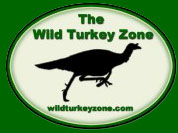|

Turkey
Communication
By T.R. Michels, Trinity Mountain Outdoors
I'd been hearing a group of turkeys gobbling since
a half-hour before daylight. They first responded
to my soft tree yelps by gobbling from the trees where
they were roosted, and within fifteen minutes I heard
them fly down. Once they were on the ground the toms
began to gobble again. To try to get the toms to come
in my direction I used a Wing Thing flapper call,
to simulate the sound of a turkey flying down. Then
I blew a Flydown Cackle on my Haydel’s mouth
diaphragm. That’s when the fun began, I’d
perform the Yelp of a hen turkey and the birds would
respond. I’d wait a few minutes, and then I’d
yelp again.
At first it seemed like the birds were coming closer,
but after an hour of calling I wasn’t so sure.
I finally decided to take a chance, and blew a loud
series of insistent Cutts. There was an almost immediate
response as a tom gobbled back. Minutes later there
was another thunderous call, but it didn’t seem
any closer. I called to the tom for another fifteen
minutes, but it wouldn’t come in. In desperation
I tried one more tactic; I began to putt and purr
softly, and then I began to rustle the leaves on the
ground beside me, like a turkey scratching for food.
Five minutes later a big tom came around the corner
of the woods, spotted my decoys, and went into a strut.
Hunters sometimes forget that communication among animals is not just sound, it
is a combination of sounds, body posture, movement,
and in mammals, scent. The difference in the meaning
between two calls that sound alike is often the body
posture or movement of the animal making the call. When
you are calling turkeys you need to understand the meaning
of the call, and when it is used. And, unless you are
using decoys, it’s difficult for you to recreate
the body posture or movement associated with the call
you are making.
Movement Sounds
There are sounds other than calling associated with
all animals. The movement of the animal alone creates
a sound that is associated by other animals as coming
from a particular species or sex of animal. Turkeys
have a way of walking and feeding that produces a
particular sound, walking deer have a different tempo
and volume. Along with the calls they make, turkeys
make a lot of scratching noises when they feed. If
a turkey hears soft putts, purrs and whines along
with the sound of soft steps and scratching in the
leaves, it thinks a flock of birds is feeding.
When turkeys fly down from the roost they often perform
the Flying Cackle, and they also produce a flapping
sound with each beat of their wings. A turkey hearing
the combination of both wing beats and Cackle thinks
another bird has flown down from its roost. A turkey
hearing a Fighting Purr expects to hear the other
sounds associated with a fight, like the flapping
of wings as the birds jump into the air and try to
peck or kick and spur each other.
When a turkey struts, it often performs the Spit
and Drum. The sounds of these two actions have been
described as a chump and a hum, which are probably
more fitting names for these sounds. The sound of
a turkey's wings dragging on the ground can also be
heard at close range when a tom struts.
As you can see it's not just the call, but the other
sounds, and the action or posture of the body, in
combination with the call, that relay the meaning
of the call to other turkeys. You cannot recreate
most of these movements and body postures while hunting,
but if you know when and why they occur you can produce
the calls and sounds at the proper time.
This article is an excerpt from the Turkey Addict's
Manual, by T.R. Michels.
T.R. Michels is a nationally recognized game researcher/wildlife
behaviorist, and outdoor writer and speaker, who has
been studying game animals for several years. He is
the author of the Whitetail, Elk, Duck & Goose,
and Turkey Addict's Manuals. His latest
books are the 2002 Revised Edition of the Whitetail
Addict's Manual, the 2002 Revised Edition
of the Elk Addict's Manual; and the 2002
Revised Edition of the Duck & Goose Addict's Manual.
For a catalog of
books and other hunting aids contact:
T.R. Michels, Trinity
Mountain Outdoors, PO Box 284, Wanamingo, MN 55983.
|

